White potato varieties (with white flesh): descriptions, characteristics and photos
Previously (especially in Soviet times) it was rather difficult to find potatoes with pink or red skin (eyes), since, as a rule, all potatoes were white, and both the skin and the pulp. Now the shelves are full of any kind of potato (yellow, pink, red), you can even find it with purple pulp. Nevertheless, it is worth knowing that the color of the peel and pulp does not affect the taste of the culture in any way. However, it is believed that potatoes with white flesh contain an increased amount of tuberin (a valuable vegetable protein), vitamin C. And, of course, white potatoes contain all other groups of vitamins, as well as antioxidants, albeit in smaller quantities than yellow ones. , red and especially purple.
Interesting! For example, in potatoes with yellow flesh increased content of vitamin A (carotene), which improves vision and skin condition, preventing it from aging. Actually, this is what he owes to his color - the more carotene, the yellower the potatoes.
Next, we suggest that you familiarize yourself with the best and most popular varieties of white potatoes, so that you can better determine the choice for buying and / or planting seed tubers in your garden.
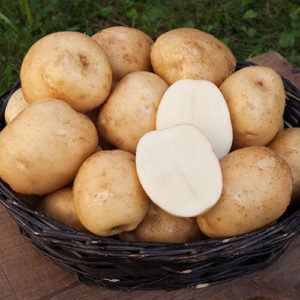
Note! In the review pwe are talking about varieties that have white flesh. The peel can be either white or cream, beige, pink or red and even purple.
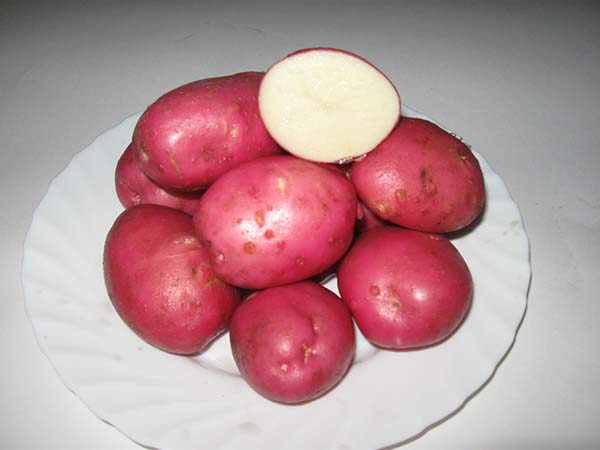
Content
Best white potatoes (with white flesh): top 14
Interesting! It is popularly believed that white potatoes with white flesh are best boiled, which means it is perfect for making mashed potatoes, red potatoes - more for frying, yellow — for soups and salads. But in fact, many other creamy, yellow (including yellow-skinned) and “red-skinned” (pink) varieties are suitable for mashed potatoes. The fact is that it is the percentage of starch that determines the taste and culinary purpose of potatoes, and in white varieties (with white pulp) there is usually more starch (but not always).
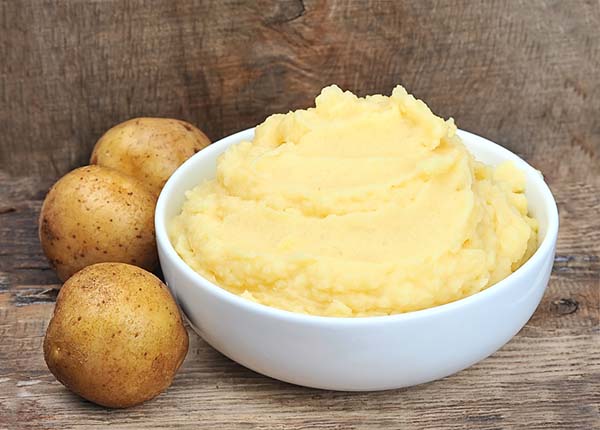
Aurora
Mid-season variety, high-yielding, excellent taste.
The variety is able to adapt to any climatic growing conditions, and is also not picky about the type of soil.
Resistant to potato crayfish and nematodes, moderately resistant to viruses, moderately susceptible to the causative agent of late blight by tops and tubers.
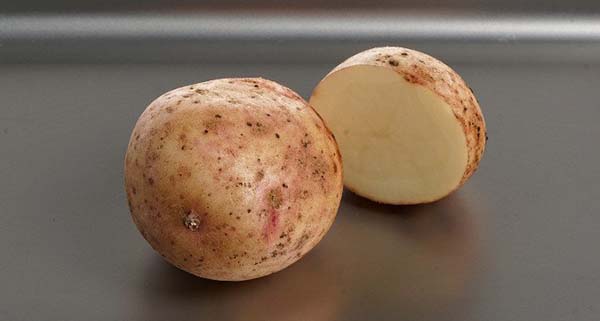
The taste is excellent. When cooked, the potatoes become crumbly (medium boiling). Culinary type VS. Suitable for mashing, baking, and also for soups and salads.
Characteristics of the Aurora variety:
- ripening period - mid-season (90-110 days);
- the shape of the tubers is oval (aligned);
- the structure of the peel is smooth;
- peel color - yellow (or pale pink);
- pulp color - white (cream);
- the depth of the eyes is shallow;
- starch content - 13.5-17.3%;
- yield per hundred square meters - 214-396 kg (maximum up to 416 kg);
- the number of tubers per bush - from 20-25;
- the average weight of 1 tuber is 93-128 g;
- marketability - 80-93%;
- keeping quality - 94%.
In appearance, it is distinguished by tall bushes with large foliage of a light green hue. The inflorescences have a red-purple hue. Berry formation is average.
Recommended for planting regions: North, North-West, Central, Volgo-Vyatka, TsChO, North Caucasian, Middle Volga, East Siberian, Far East.
Patent holder or originator of the variety: LLC Vsevolozhskaya breeding station (Russia).
Alyona
An early variety with good yield and taste.
The variety has a stable yield, a consistent return of early production, resistance to drought and suitability for mechanized cultivation technology.
Responds very well to germination.
Resistant to the causative agent of potato cancer, susceptible to nematodes. Susceptible to late blight. Resistant to common scab, rhizoctonia.
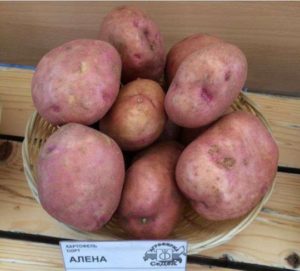
The taste is good. Culinary type VS. The digestibility is moderate. The pulp does not darken. Suitable for purees, soups, salads and frying. Suitable for making crispy potatoes and French fries.
Characteristics of the Alena variety:
- ripening period - early (70-80 days);
- tubers are oval;
- the structure of the peel is smooth;
- peel color - red;
- the color of the pulp is white;
- the depth of the eyes is shallow;
- starch content - 15-17%;
- yield per hundred square meters - 172-292 kg (maximum up to 391 kg);
- the number of tubers per bush - 6-10;
- the average weight of 1 tuber is 86-167 g;
- marketability - 81-97%;
- keeping quality - 95%.
The appearance of the plant - bushes of medium height, intermediate type, spreading. The leaf is large, wide, green. No or very slight waviness in the edge. Inflorescences are medium in size, reddish-purple. Berry formation is very rare.
Recommended for planting regions: Volgo-Vyatka, Ural, West Siberian, East Siberian, Far East.
Patent holder and / or originator of the variety: Federal State Budgetary Scientific Institution "Omsk ANC" (Russia).
Elizabeth
Medium early variety, high yield and good taste.
It is characterized by early harvest accumulation and good keeping quality during winter storage.
Resistant to cancer and common scab. Moderately resistant to rhizoctonia. It is characterized by an average (moderate) susceptibility to late blight, but in the years of epiphytoties it is strongly affected. Susceptible to nematode.
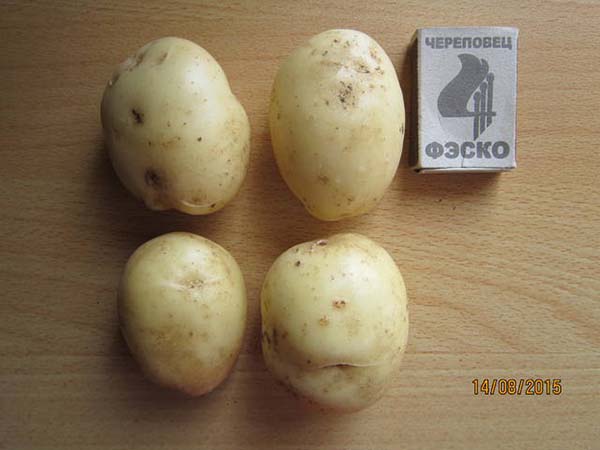
Good taste. Culinary type of the sun (cooking moderation). The pulp does not darken. Good for mashed potatoes and baked, and can also be used for starch and crisps (chips and fries). Suitable for first courses (soups) and salads.
Characteristics of the Elizaveta variety:
- ripening period - medium early (80-90 days);
- the shape of the tubers is round;
- the structure of the peel is smooth;
- peel color - white;
- the color of the pulp is white;
- the depth of the eyes is shallow;
- starch content - 12.0-18.4%;
- yield per hundred square meters - 290-400 kg (maximum up to 445 kg);
- the number of tubers per bush - 13-16;
- the average weight of 1 tuber is 83-143 g;
- marketability - 79-96%;
- keeping quality - 93%.
The appearance of the plant is an erect, compact, medium height bush. Leaves are medium. Inflorescences are white. No berry formation.
Recommended for planting regions: North, North-West, Central, Volgo-Vyatka, North Caucasian, Far East.
Patent holder and / or originator of the variety: Federal State Budgetary Scientific Institution "Leningrad Scientific Research Institute of Agriculture" Belogorka "(Russia).
Zhukovsky early
Early variety, high yield and medium flavor.
Perfectly adapts to changing climatic conditions, relatively heat and drought resistant. The yield is stable.
Important! Zhukovsky grows amicably even in poorly warmed soil, so the variety can be safely planted at the end of April.
Resistant to potato crayfish and nematodes. Susceptible to tops and tubers to the causative agent of late blight. The tubers are resistant to mechanical damage.
The taste is satisfactory and good. Culinary type B. Boiled weak. During the cooking process, the pulp darkens slightly. Great for frying, soups, salads, fries and chips. Can be used for puree and cooking, but not very suitable.
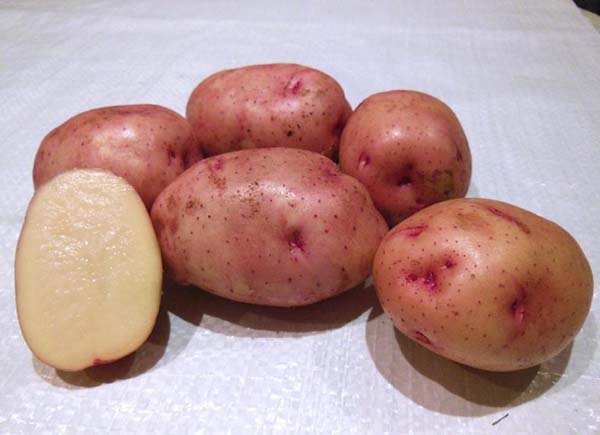
Characteristics of the early Zhukovsky variety:
- ripening period - early (70-80 days), according to other sources, very early (60-80 days);
- the tubers are oval-round;
- the structure of the peel is smooth;
- peel color - pink;
- the color of the pulp is white;
- the depth of the eyes is shallow;
- starch content - 10-12%;
- yield per one hundred square meters - 400-450 kg;
- the number of tubers per bush - 9-15;
- the average weight of 1 tuber is 100-120 g;
- marketability - 90-92%;
- keeping quality is good.
Appearance - bushes of medium height, semi-spreading stem type, the leaf is small, green (glossy), the flowers have a red-purple hue. Berry formation is rare.
Recommended for planting regions: North-West, Central, Volgo-Vyatka, Central black earth, North Caucasian, Middle Volga, Nizhnevolzhsky, Ural, West Siberian, Far East.
Patent holder and / or originator of the variety: FGBNU “All-Russian Research Institute of Potato Farming. A.G. Lorkha (Russia).
Kiwi
Late ripening variety, high yield and mediocre (normal) taste.
Note! Planting material is very difficult to find due to its rarity. But as they say, he who seeks will always find.
Perfectly adapts to any climatic conditions. Kiwi can grow in any type of soil.
It is practically not damaged by the wireworm and the Colorado potato beetle (since it contains bio-fiber). It is also not affected by late blight, common scab, late blight, potato cancer.
Interesting! The elongated tubers have a rough mesh surface that resembles a kiwi peel, which gave the species its name.
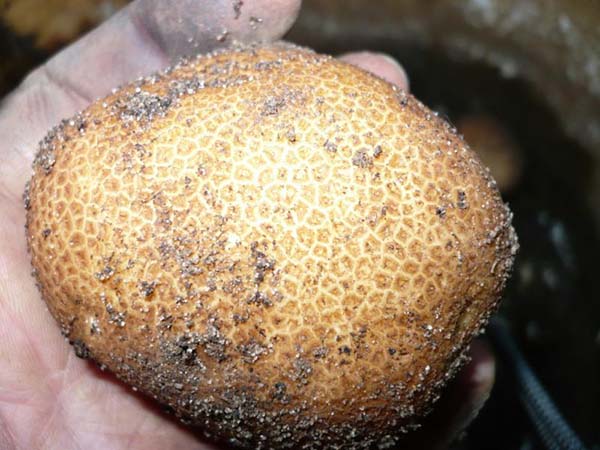
Taste is fair or mediocre (practically tasteless). When cooking, the friability is average. Suitable for puree. Almost not suitable for frying, as it burns due to the high dry matter content.
Characteristics of the Kiwi variety:
- ripening period - late ripening (120-140 days);
- the shape of the tubers is round;
- peel structure - rough (mesh);
- peel color - orange-brown;
- the color of the pulp is white;
- the depth of the eyes is shallow;
- starch content - unknown;
- yield per hundred square meters - high (up to 400 kg);
- the number of tubers per bush is unknown;
- the average weight of 1 tuber is unknown;
- marketability - unknown;
- keeping quality is good.
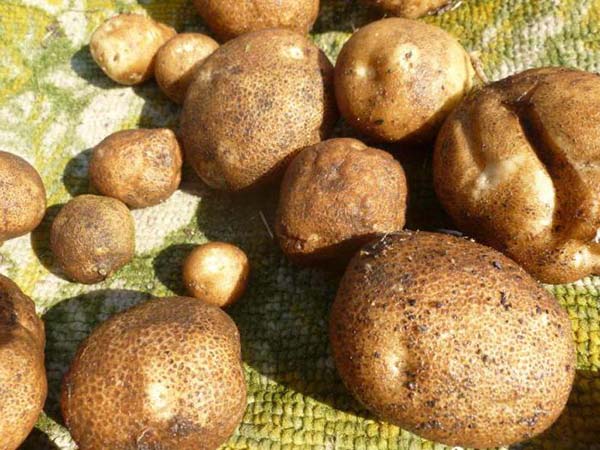
Differs in tall bushes, with a large number of densely leafy shoots. Inflorescences have a rich lilac hue, but rarely blooms.
Recommended for planting regions (presumably): Central.
Patent holder and / or originator of the variety: unknown (according to some sources, the variety is GMO, but this is inaccurate).
Lorch
Medium late variety, good yield and excellent taste.
By the way! One of the oldest Russian potato varieties, registered in 1931, and bred by Alexander Georgievich Lorkh in 1922.
Possesses high plasticity to cultivation conditions.
Important! It does not tolerate drought and slows down its growth at high temperatures, which leads to the formation of children and provokes sprouting (a new tuber appears from the finished development).
Moderately susceptible to late blight in tops and tubers, common scab, moderately resistant to rhizoctonia.
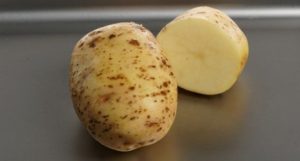
Lorkh's taste is excellent. Culinary type C. The digestibility is good. Ideal for puree. During the cooking process, the shade of the pulp does not darken. Suitable for starch production.
Characteristics of the Lorkh variety:
- ripening period - medium late (110-120 days);
- tubers are round-oval;
- the structure of the peel is smooth, flaky at the top;
- peel color - light beige;
- the color of the pulp is white;
- the depth of the eyes is shallow;
- starch content - 15-20%;
- yield per hundred square meters - 250-350 kg;
- the number of tubers per bush - 15-25;
- the average weight of 1 tuber is 90-120 grams;
- marketability - 88-92%;
- keeping quality is good.
The appearance of the plant is tall, has well-branched leafy shoots and medium-sized light green leaves. Differs in pale reddish-purple flowers, with white edging around the edge of the petals. Berry formation is rare.
Regions recommended for planting: North-West, Central, Central Black Earth Region, North Caucasian, Middle Volga, Nizhnevolzhsky, Uralsky.
Patent holder and / or originator of the variety: FGBNU “All-Russian Research Institute of Potato Farming. A.G. Lorkha (Russia).
Lugovskoy
Mid-season growth, high yield, good taste.
It is characterized by a stable yield. Can be grown in almost any climatic conditions.
In the process of cultivation, it responds well to hilling and deep loosening of the soil.
Resistant to cancer, relatively resistant to late blight, common scab, moderately resistant to viruses, blackleg.
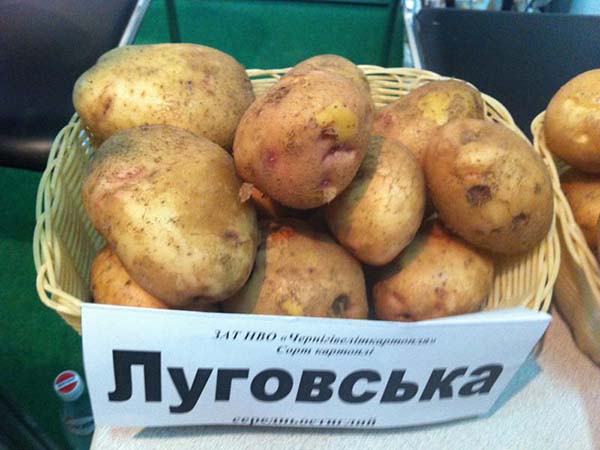
The taste is good, without excessive dryness and wateriness. The pulp does not darken. Lugovsky is recommended for making mashed potatoes and getting starch.
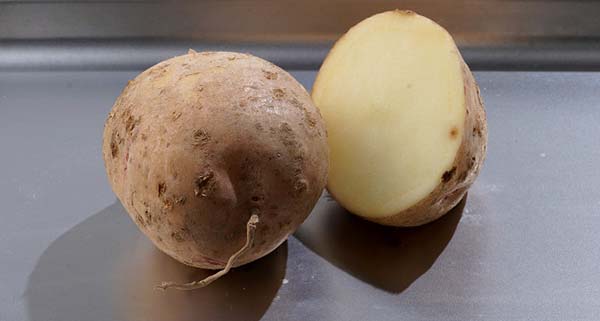
Characteristics of the Lugovskoy variety:
- ripening period - mid-season (90-110 days);
- tubers are oval;
- the structure of the peel is mesh;
- peel color - light pink;
- the color of the pulp is white;
- the depth of the eyes is shallow;
- starch content - 12-19%;
- yield per hundred square meters - high (maximum up to 514 kg);
- the number of tubers per bush - 10-15;
- the average weight of 1 tuber is 85-125 g;
- marketability - high;
- keeping quality is good.
The appearance of the plant is erect, of medium height, the color of the flowers is white.
Recommended for planting regions: North, North-West, Central, Volgo-Vyatka, Central Black Earth Region, North Caucasian, Nizhnevolzhsky, Ural, West Siberian, East Siberian, Far East.
Patent holder and / or originator of the variety: Institute of Potato Growing UAAS (Ukraine).
Lyubava
Early variety, high yield, good taste. Culinary type A (salad type). Doesn't boil over. The pulp darkens moderately during cooking.
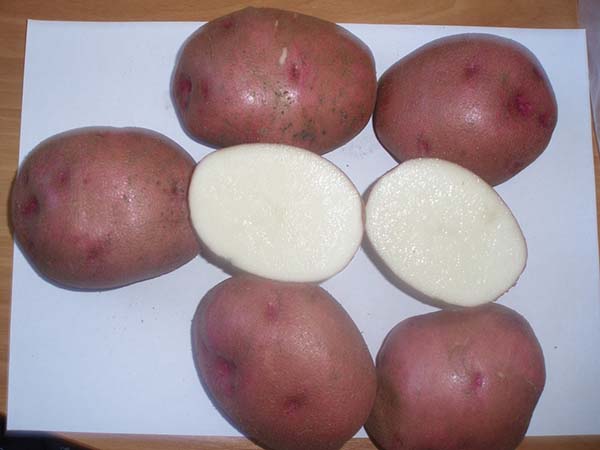
Resistant to the causative agent of potato cancer, rhizoctonia, susceptible to nematode. It is also susceptible in terms of tops and moderately resistant in tubers to the causative agent of late blight. Moderately resistant to common scab.
Characteristics of the Lyubava variety:
- ripening period - early (70-80 days);
- the shape of the tubers is oval-round;
- the structure of the peel is from medium to coarse (according to other sources, it is generally suitable, but flaky at the top);
- peel color - red;
- the color of the pulp is white;
- the depth of the eyes is average;
- starch content - 11.2-16.9%;
- yield per one hundred square meters - 288-400 kg (maximum up to 524 kg);
- the number of tubers per bush - 8-15;
- the average weight of 1 tuber is 109-210 g;
- marketability - 80-98%;
- keeping quality is good.
The appearance of the bushes is of medium height, intermediate type, semi-erect. The leaf is small, open, light green. The waviness of the edge is weak. Average gloss. Inflorescences are medium in size, reddish-purple. Berry formation is rare.
Recommended for planting regions: Ural, West Siberian, East Siberian, Far East.
Patent holder and / or originator of the variety: FGBNU “All-Russian Research Institute of Potato Farming. A.G. Lorkha (Russia).
Nevsky
Medium early variety, high yield and average (satisfactory) taste.
By the way! According to some sources, the most popular potato variety in Russia.
Suitable for all regions. Nevsky gives good results when grown on sandy and loamy soils with a deep arable layer. Resistant to drought and waterlogging.
Important! When planting, it requires preliminary warming up of the seed (it is impossible to plant immediately into cold soil), it is sensitive to the breaking off of sprouts. Responds well to plentiful feeding. To avoid scab damage, requires moist soil at the time of tuber formation.
Resistant to the causative agent of potato cancer, rhizoctonia, potato viruses. Moderately resistant to common scab. Moderately susceptible to late blight in tops and tubers. Resistant to mechanical damage. However, tubers tend to germinate during long-term storage.
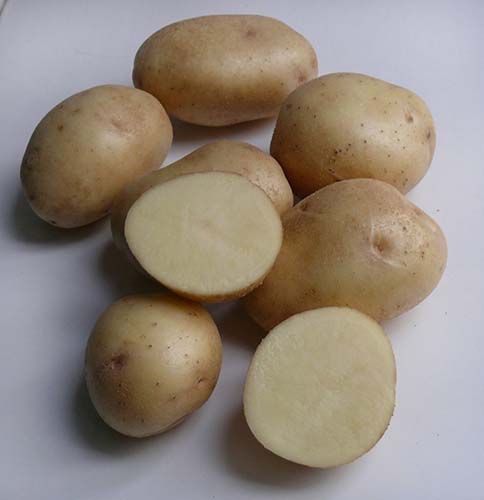
The taste is satisfactory or good. Culinary type VS. The digestibility is poor. The pulp does not darken during the cooking process. This means that Nevsky is suitable for preparing first (soups) and second courses (salads), but due to the low starch content, it is not very suitable for mashed potatoes, but very suitable for frying.
Characteristics of the Nevsky variety:
- ripening period - medium early (80-90 days);
- the shape of the tubers is oval, aligned;
- the structure of the peel is smooth or mesh;
- peel color - light beige with pink eyes;
- the color of the pulp is white;
- the depth of the eyes is shallow;
- starch content - 10-12%;
- yield per hundred square meters - 380-500 kg;
- the number of tubers per bush - 17-20;
- the average weight of 1 tuber is 90-130 g;
- marketability - 90-95%;
- keeping quality is good.
The appearance of the plant is semi-erect, intermediate type, of medium height. The leaf is medium, light green, the waviness of the edge is weak. The flowers are white. Berry formation is average.
Recommended regions for planting: absolutely all regions.
Patent holder and / or originator of the variety: Federal State Budgetary Scientific Institution "Leningrad Scientific Research Institute of Agriculture" Belogorka "(Russia).
Roco (Rocco)
Mid-season variety, medium yield, good taste.
Differs in yield stability even under the most unfavorable conditions. Rocco prefers loamy, sandy or soddy soil with neutral acidity.
It is resistant to the causative agent of potato cancer and golden potato cyst nematode. Moderately resistant to late blight in tubers and moderately susceptible to tops. Resistant to wrinkled and striped mosaics.
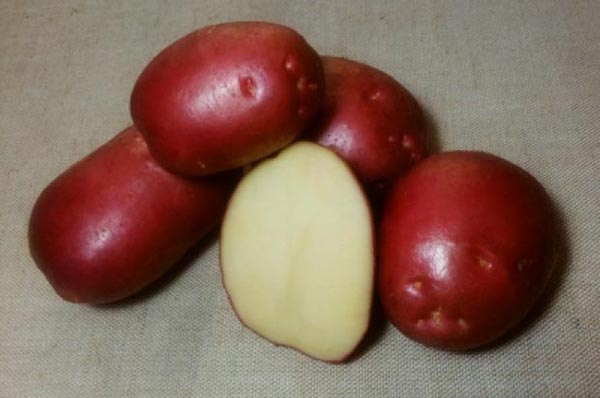
The pulp tastes good to excellent. Does not boil over during cooking. Suitable for processing into crispy potatoes, i.e.for making chips and fries. And also for salads, soups and frying.
Characteristics of the Roco variety:
- ripening period - mid-season (90-110 days);
- tubers are oval;
- the structure of the peel is smooth;
- peel color - red;
- pulp color - cream (white);
- the depth of the eyes is shallow;
- starch content - 12.9-14.5%;
- yield per hundred square meters - 136-261 kg (maximum up to 275 kg); 0
- the number of tubers per bush - 8-12;
- the average weight of 1 tuber is 75-119 g;
- marketability - 84-96%;
- keeping quality - 89%.
The appearance of the plant is of medium height, intermediate type, semi-erect. The leaf is medium sized, open, green. The waviness of the edge is medium. The flowers are large, reddish-purple.
Recommended for planting regions: Volgo-Vyatka, Srednevolzhsky, West Siberian.
Patent holder and / or originator of the variety: Niederosterreicische Saatbaugenossenschaft (Austria).
Ryabinushka
Medium early variety, high yield, good taste.
The variety easily adapts to agro-climatic conditions, has a high heat and drought resistance. It responds well to watering and timely fertilization. It is recommended to germinate the tubers before planting.
It is highly resistant to damage by the Colorado potato beetle. The variety is resistant to mechanical damage. Resistant to the causative agent of potato cancer and nematodes. Moderately susceptible to tops and moderately resistant to tubers to the causative agent of late blight.
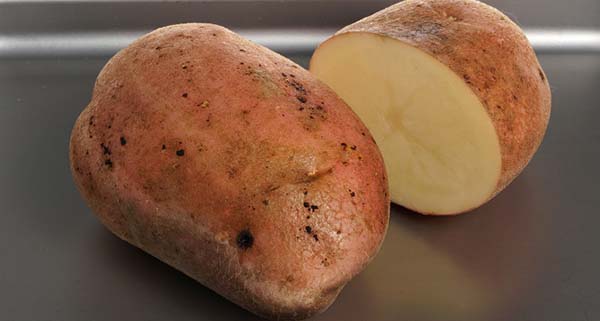
The taste is good. Culinary type B. The boil-off is weak. The pulp does not darken during cooking. Suitable for soups, salads and frying.
Characteristics of the Ryabinushka variety:
- ripening period - medium early (80-90 days);
- tubers are oval;
- the structure of the peel is smooth;
- peel color - red;
- pulp color - white (cream);
- the depth of the eyes is shallow;
- starch content - 11.9-15%;
- yield per one hundred square meters - 220-234 kg (maximum up to 396 kg);
- the number of tubers per bush - 15-18;
- the average weight of 1 tuber is 91-133 g;
- marketability - 86-96%;
- keeping quality - 90%.
The appearance of the plant is medium or tall, semi-erect. Medium or large leaves are dark green in color, and the inflorescences are violet-blue. Berry formation is absent.
Recommended for planting regions: North, North-West, Central, Volgo-Vyatka, Central Black Earth region, North Caucasian, Middle Volga, West Siberian, Far East.
Patent holder and / or originator of the variety: LLC Vsevolozhskaya breeding station (Russia).
Sineglazka (Hannibal)
Mid-season variety, high yield, excellent taste.
A variety of folk selection, and cannot be found in the official sale.
Relatively resistant to late blight, common scab.
The variety is not picky about care. It prefers to grow in light sandy soil with a low acidity index, otherwise the yield is significantly reduced.
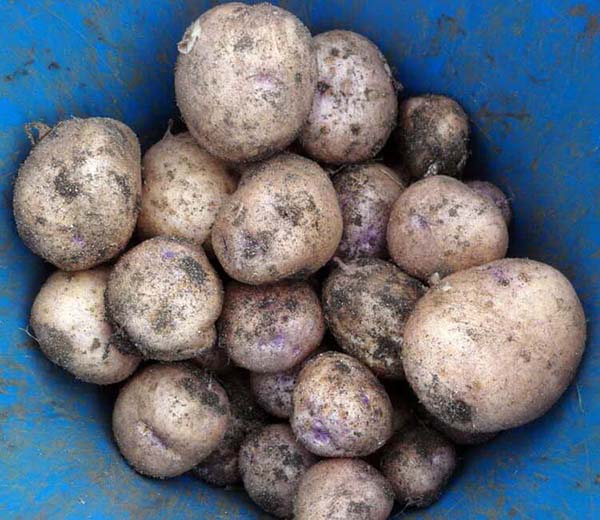
The taste is excellent; the pulp boils well during cooking. Recommended for making puree.
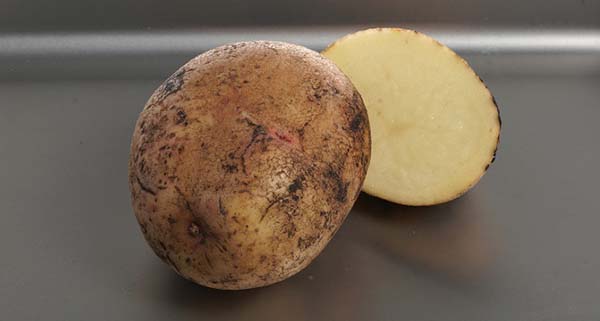
Characteristics of the Sineglazka variety (unofficial):
- ripening period - mid-season (90-110 days);
- the shape of the tubers is oval-oblong;
- the structure of the peel is mesh;
- peel color - cream;
- the color of the pulp is white;
- the depth of the eyes is dark blue, shallow;
- starch content - 15-17%;
- yield per hundred square meters - up to 500 kg;
- the number of tubers per bush - 8-12;
- the average weight of 1 tuber is 70-130 g;
- marketability - unknown;
- keeping quality is low.
The appearance of the plant is strong tall bushes with densely leafy shoots. Leaves are medium in size, dark green. Inflorescences are light lilac with a bright yellow core.
Recommended for planting regions (presumably): Central.
Patent holder and / or originator of the variety: did not undergo official agrotechnical tests on the territory of the Russian Federation, and, accordingly, was not included in the State Register (unknown).
Sonny (Bogatyr)
Late variety, good taste.
A variety of folk selection. Cannot be found in the official sale.
Not picky about the composition of the soil, but, of course, it gives the best results on fertile land. It adapts well to any agro-climatic conditions. It tolerates prolonged heat or cold summer, lack of sun. Almost does not suffer from droughts and prolonged rains.
The Sonnok variety is resistant to cancer, scab and nematodes. It has good resistance to late blight.
Good or excellent taste. Suitable for all kinds of dishes.
Characteristics of the variety Sonok (unofficial):
- ripening period - late (120-140 days);
- the shape of the tubers is oval (slightly flattened) or round-flat;
- the structure of the peel is mesh;
- peel color - pinkish cream;
- pulp color - white (cream);
- the depth of the eyes is shallow;
- starch content - 12-14%;
- yield per one hundred square meters - unknown (about 10 kg per bush);
- the number of tubers per bush - 15-20 (maximum up to 40);
- the average mass of 1 tuber is at least 75-85 g (but as a rule, all tubers are very large, more than 100 grams);
- marketability - unknown;
- keeping quality - 92-95%.
The appearance of the plant is medium-sized bushes with erect shoots. Inflorescences are large, white. Berry formation is rare.
Recommended for planting regions (presumably): Central, TsCHO.
Patent holder and / or originator of the variety: did not undergo official agrotechnical tests on the territory of the Russian Federation, and, accordingly, is not included in the State Register.
Luck
Early variety, high yielding, normal (fair) taste.
Productivity is stable in a favorable climate for crops. The choice of soil does not matter. It tolerates well both waterlogging and lack of moisture in the soil.
Moderately susceptible to late blight in tops and moderately resistant to tubers. Not damaged during transportation (resistant to mechanical damage).
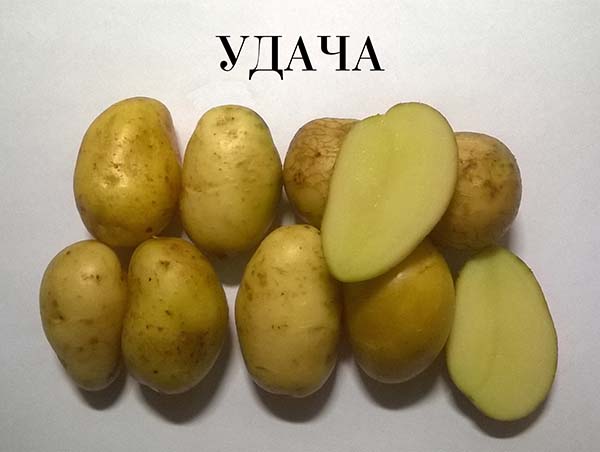
Fair to good taste. Culinary type B. The digestibility is weak, the pulp darkens slightly. Suitable for making soups and salads, as well as frying, fries and chips. But, according to some reports, it is also suitable for making mashed potatoes.
Characteristics of the Luck variety:
- ripening period - early (70-80 days);
- tubers are round-oval;
- the structure of the peel is smooth;
- peel color - light beige (cream);
- the color of the pulp is white;
- the depth of the eyes is shallow;
- starch content - 12-15%;
- yield per hundred square meters - 300-500 kg;
- the number of tubers per bush - up to 10-14;
- the average weight of 1 tuber is 100-150 g;
- marketability - 96%;
- keeping quality is good.
The appearance of the plant is medium, semi-spreading. Leaves with large lobes, dark green. Inflorescences are snow-white. Berry formation is rare.
Recommended regions for planting: North-West, Central, Volgo-Vyatka, Central Black Earth Region, North Caucasus, Middle Volga, Ural, Far East.
Patent holder and / or originator of the variety: FGBNU “All-Russian Research Institute of Potato Farming. A.G. Lorkha (Russia).
Other white varieties
Less popular, but still well-known and quite good varieties of white potatoes are (alphabetically):
- White dew;
- Snow White;
- Bryansk is reliable;
- Detskoye Selo;
- Minerva;
- Naiad;
- Petersburg;
- Tiras;
- Gypsy (purple rind);
- Aerrow.
All other varieties of white potatoes (alphabetically): Ivory Russet, Akrosia, Barin, Batya, Bafana, Bashkirsky, Belousovsky, Bryansk new, Bryansk red and early (2 different varieties), Varmas, Cornflower (purple-skinned), Inspiration, White spring, Messenger, Veteran, Volare, Volzhanin, Dove, Goryanka, Divo, Donetsk, Evgiriya, Eurostarch, Ermak improved, Peter's riddle, Zabytok, Ilyinsky, Spark, Carlingford, Kolpashevsky, Beauty, Red rose, Kuznechanka, Lazar , Lapis Lazuli, Gourmet, Lady Lenora, Leader, Lina, Lyubimets, Malamur, Robin, Lighthouse, Moskvoretsky, Mostovsky, Nalchik, Nart, Narymka, Nida, Nikulinsky, Nocturne, Olympus, In memory of Kulakov, Penza skorospelovets, Pogar, Pobeda Flight, Foothill, Priobsky, Pushkinets, Ramensky, Real, Reserve, Resource, Samara, Santana, September, Sineva, Sifra, Fairytale, Rapid, Bullfinch, Tarasov, Tomich, Tulunsky early, Udalts, Ural early, Torch, Filatovsky, Khibinsky , Hostess, Wizard, Effect, Zhukov's Jubilee.
Thus, the variety of white potato varieties meets almost all the taste and agrotechnical requirements that a simple consumer or gardener who wants to grow his own potatoes in a summer cottage can put forward.

